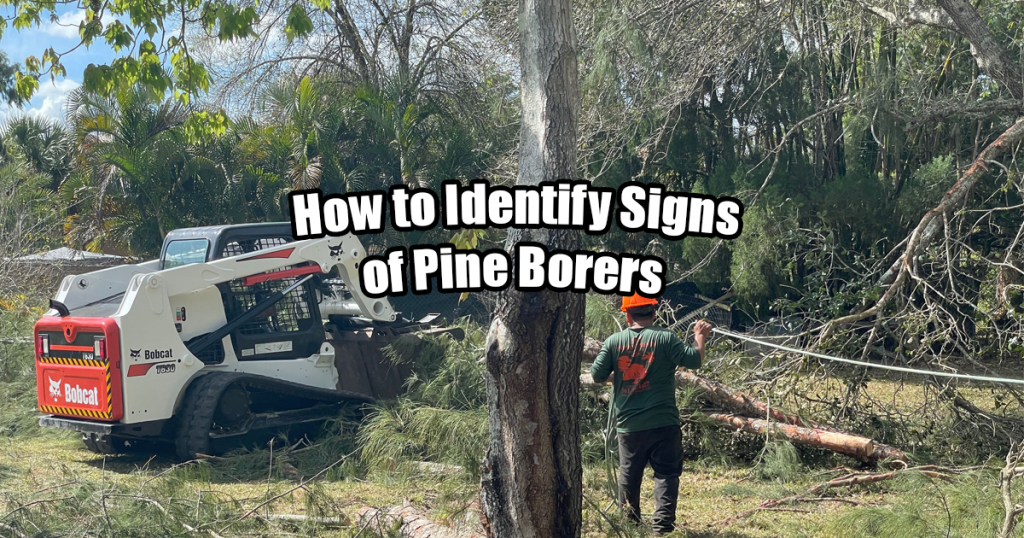
There are over a hundred different species of pine trees that are commonly used in the US. Of all Genus Pinus, the most common native trees are the pitch pine, white pine, Monterey pine, red pine, and shortleaf pine. Popular species of non-native introduced pines are the Austrian pine, Mugo pine, Japanese black pine, and Scots pine. These beautiful trees can add charm and character to any landscape. Regardless of where a pine originates from, they all share a common enemy- borer insects.
What Threat Do Pine Borers Pose?
All types of pine trees are susceptible to borer insects, and they are the only insect which has the potential to kill a pine tree. Borer insects are so dangerous because they will go under the bark to feed. Borer insects damage phloem and interrupt vascular tissue in the areas of the tree where they feed. If a pine tree is already stressed due to damage to its roots, drought, or disease, then death by borer insects will be rather swift. Most pine borer insects also have fungi on their bodies which further caused vascular distress in pine trees.
Many borer insects will tunnel under the bark while they are in their larval stages. They will feed on the tree to the point of death, often without the landowner being aware there is even a problem. Their tunneling and feeding habits destroy the tree’s conductive tissue, destroy the cambium, and interfere with sap flow. Other borer insects like the Scolytid beetle will attack the large lateral roots and the lower portion of the pine tree trunk. They will bore through both the outer and inner bark and lay eggs in the holes left behind. To speed up the process, some borer insects even emit pheromone odors that attract more insects to the compromised pine tree.
The most common fungus carried by borer insects is the Leptographium sp, a blue-stain fungus. Most borer outbreaks occur during dry seasons or droughts. A simple infestation can quickly lead to the death of all pine trees in the immediate area unless affected trees have been removed. Typically, if an outbreak occurs in one area, there will be repeated outbreaks for the next several years.
If you think you see any signs of pine borers, let us help stop the infestation.
Common Signs of Pine Borers
It is often difficult to know when a pine tree has been attacked by borer insects until the damage is too severe to treat. Borer insects hide under the bark and out of sight, killing the pine tree from within. Advanced symptoms are typically the first to be seen, but early detection can save surrounding trees. If you notice that your pine trees have needles that are turning yellow, it is a classic sign that something is amiss. Pines are generally evergreen and any change in color of live needles is a symptom of stress or decay.
Another common sign of a borer insect infestation is holes in the bark or tree that are oozing sap. Unless a tree has become damaged, there is no reason for it to ooze sap. Holes that exude sawdust are also signs of a borer infestation. Sometimes you may see insects or bugs crawling around these areas, but usually, by this time, the tree is no longer viable.
Trees At Risk Of A Pine Borer Infestation
Pine trees that are most at risk of being attacked by borer insects are those that already suffer bark or root injuries. These injuries can come from any source such as storm damage, pruning damage, or even illness. New pine trees are also especially susceptible. Pine trees are well known for being almost drought resistant, however, when a pine is stressed to due inadequate moisture levels, they are also more prone to a borer attack. Properly cared for pine trees that have ample hydration will only be attacked by borer insects if there happens to be a high concentration of the pests in the area. Pine trees that are newly planted, recently transplanted as well as pine trees located on construction sites especially vulnerable to borer attacks.
What To Do If You Find Signs of Pine Borers?
If you notice signs of borer insects in your pine trees, it is critical that you contact a skilled arborist or tree care specialist as soon as possible. It is a good idea to hire a tree care service to routinely monitor your pine trees for borer attacks. Regular tree care also will alert you to injuries or damage to your pines that may put them at risk of being attacked. The tree care company should have a trained PHC Specialist that is able to examine all the pines and woody plants on your property to check for borer insects and other pests that may harm your pine trees.
In the event an arborist identifies your pine trees are under duress, or that there is a large concentration of insects in the area, A treatment can be applied to the bark. This is a preventative measure more than active treatment, however, it can keep healthy trees from falling victim to a borer attack. The best way to prevent attacks is by keeping your trees healthy with regular pruning, watering, and fertilization. Root collar excavation is also recommended, but should only be performed by a trained professional. During a drought season, you can reduce the stress on your pine trees through deep watering. The only recourse for a seriously infested tree is removed before the borer insects pass on to other trees in the area.
How To Help Your Pine Trees Protect Themselves From Borer Insects
Borers are most successful when they attack as a group. They target trees that are stressed due to drought and pine trees planted in the shade. Pines thrive in direct sun and healthy pine trees are able to dislodge and expel borer insects out in their sap. Pine trees should always be well watered and get plenty of sun. This will give them the energy and nutrients they need to produce poisons in their sap that will kill most diseases borer insects spread.
